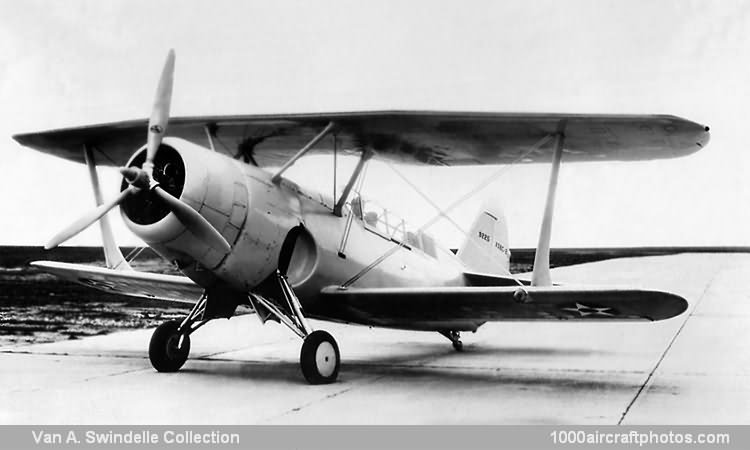XSBC-2. This was a relatively conventional biplane of mixed construction. Fuselage and fixed tail surfaces were metal monocoque and the wings were metal frame with metal skin on the tapered upper wing and fabric on the straight-chord lower wing. The movable controls were fabric covered and full-span flaps were fitted to the lower wing. The stiff mono spar construction of the one-piece upper wing allowed use of single I-struts instead of the traditional N-struts. Cockpit enclosures and a collapsible rear turtle deck similar to those of the SOCs were used. By the time the XSBC-2 flew on December 9, 1935, the fourteen-cylinder two-row air-cooled radial engine had been considerably improved and was ready for another trial; the 700 hp XR-1510-12 version was used but did not prove satisfactory.
XSBC-3. Because the Wright engine of the XSBC-2 proved unsatisfactory, a very similar 700 hp Pratt & Whitney R-1535-82 Twin Wasp Junior was substituted in March 1936. The aeroplane was then redesignated XSBC-3. Its performance in this configuration resulted in production models to which Curtiss reapplied the name Helldiver.
SBC-3. In August 1936 the USN ordered 83 production SBC-3s with 750 hp R-1535-94 Twin Wasp Junior engines, these were produced under the Curtiss Model number 77A. Under BuNos. 0507 to 0589 deliveries began on July 17, 1937, with one being held at the factory for conversion to the XSBC-4 prototype. All went to carrier-based units in the fleet, where some served into late 1941 before being relegated to training units.
XSBC-4. The eighth-from-last SBC-3, BuNo. 0582, was kept at the factory and became the first of two XSBC-4s (Curtiss Model 77B) by change to the single-row 750 hp Wright R-1820-22 Cyclone engine that revised the nose contours considerably. A second XSBC-4 resulted from the diversion of the first production SBC-4, BuNo. 1268, to test work.
SBC-4. Starting on January 5, 1938, 124 production SBC-4s with 850 hp Wright R-1820-34 Cyclone engines were ordered under BuNos. 1268 to 1325, 1474 to 1504, and 1809 to 1843. Fifty (BuNos. 4199 to 4248) were added later but did not increase the total inventory. The first example, 1268, was used for test work as the second XSBC-4.
The SBC-4 was the last combat biplane produced for the USN. Although some were assigned to Navy fleet units and to the USMC following the start of deliveries in March 1939, the Navy finally acknowledged the end of the combat biplane era and had many of the SBC-4s delivered directly to the reserve training squadrons.
Early in 1940, France ordered ninety export versions of the SBC-4. Soon afterward, the USN responded to US Government desire to aid France by releasing fifty of its SBC-4s to France to hasten French acquisition of the type. These were returned to the factory for refurbishment and application of French markings and were later replaced by fifty of the French models then under construction.
Most of the French SBC-4s had been loaded aboard a French aircraft carrier when France fell in June 1940. The carrier was diverted to the French island of Martinique, where it sat out the war and where the SBC-4s were eventually scrapped. Five of the French SBC-4s not aboard the carrier reached the UK, where they were named Cleveland and received RAF serials AS467 to AS471. Found unsuitable for combat, the Clevelands became instructional airframes.
Two carrier squadrons of USN SBC-4s were in service at the time of the attack on Pearl Harbor and the USMC kept a squadron of land-based SBC-4s in service until June 1943."
|
A |
XSBC-2 |
SBC-3 |
SBC-4 |
